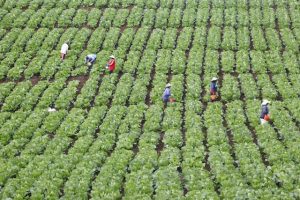
As the planet continues to reel from the damage of climate change, adopting sustainable agriculture practices is central to achieving a greener future.
Mounting fears over rising population and food insecurity rates also highlight the situation’s urgency. The need for a global transition is more imperative than ever.
If you’ve been keeping tabs on the farming industry, you probably know about its massive environmental footprint, spanning resource demand, energy consumption and greenhouse gas emissions.
Here are 10 critical techniques for overturning this deficit and promoting eco-conscious living.
1. Crop Rotation

Rotating different crops in the same area across seasons helps prevent soil depletion by alternating nutrient demands. This practice allows the land to replenish natural supplies, allowing it to sustain more farming cycles. Some farmers are strategic in their approach, cultivating crops that enrich the ground for the next set. For example, planting legumes after cereals can restore nitrogen levels in the soil.
2. Agroforestry
Agriculture accounts for a massive chunk of deforestation, primarily through livestock farming. Agroforestry integrates trees into animal or crop production systems to create more diverse land use. This approach improves biodiversity, enhances soil quality and can provide additional income sources from fruits and timber.
3. Cover Cropping
Planting and harvesting activities often accelerate erosion, leaving the topsoil with inadequate vegetation cover and, therefore exposed to runoff — a major environmental problem. Cover cropping helps prevent this by cultivating select plants during the off-season to protect and enrich the soil. Farmers often use rye as a winter cover crop because it can withstand 30-degree Fahrenheit temperatures once established, preventing soil erosion and capturing excess nutrients.
4. Conservation Tillage

This sustainable farming practice minimizes soil disturbance by reducing the frequency and intensity of tilling. It includes methods like reduced tillage and no-till, where you plant directly into undisturbed soil, preserving moisture and improving carbon sequestration. Conservation tillage is an excellent way to foster natural decomposition to enhance the soil’s organic matter, reducing the need for synthetic fertilizer applications.
5. Vertical Farming
Urban areas occupy vast space, reducing the available agricultural land. Incidentally, people in cities demand the most food products, which is why vertical farming is such a game changer. It involves growing crops in stacked layers or vertically inclined surfaces within massive, controlled environments. Vertical farms use significantly less land and allow year-round production regardless of climate conditions — a huge win for urban food security.
6. Organic Farming
Organic farming focuses on avoiding synthetic fertilizers and pest control measures, relying instead on natural compost and green manure to enrich ground fertility. These practices improve soil health over time while producing food free from harmful chemicals. For example, vegetable farmers often grow crops like basil or catnip together for mutual benefit—to naturally deter pests.
7. Smart Water Management and Irrigation
Agriculture accounts for 70% of global freshwater withdrawals, causing widespread scarcity. At this rate, 84% of the world’s farmlands could face a severe water crisis by 2050. Smart water management tools help farmers conserve resources and minimize waste by applying the right amount at the right time. For example, drip irrigation systems deliver water directly to plant roots, significantly reducing evaporation and ensuring that crops receive consistent moisture.
8. Permaculture Principles

Permaculture is a sustainable agriculture practice focused on self-sufficiency and resilience. It emphasizes organizing land based on usage intensity to maximize efficiency while minimizing waste. For instance, on a permaculture farm, you might integrate a vegetable garden near your house for easy access and cultivate fruit trees further away to reduce maintenance needs. This holistic approach fosters biodiversity and improves ecosystem resilience against pests.
9. Soil Carbon Sequestration
According to a recent study, implementing soil carbon sequestration in farming could offset 4% of greenhouse gas emissions yearly until 2100. This technique captures atmospheric carbon dioxide and stores it in the soil through various agricultural practices. A critical point in this development would be the complete shift to renewable energy sources like biomass and biofuels to replace CO2-emitting fossil fuels.
10. Aquaponics
Aquaponics combines fish farming with hydroponics — growing plants without soil — in a mutually beneficial environment. The setup is common across Asia, where rice paddies help filter and purify the water for the fish while the fish waste provides organic nutrients for the plants. Because of its closed-loop system, farmers can manage resources better and limit waste, highlighting its potential for providing sustainable food sources in urban settings.
Prioritize Sustainable Agriculture Practices
Eco-conscious farming is a strategic priority for protecting against climate change and ensuring adequate food supply for future generations. As always, favorable policies, institutional investment and individual participation are crucial for successfully implementing these practices. Lend your support wherever possible and play your part in driving sustainable change.
![]()
Author Profile
- Passionate content creator, contributor, freelance writer and content marketing allrounder.
Latest entries
 Green Home GuidesJune 9, 2025Sustainable Custom Wardrobes: Redefining Luxury with Eco-Conscious Craftsmanship
Green Home GuidesJune 9, 2025Sustainable Custom Wardrobes: Redefining Luxury with Eco-Conscious Craftsmanship Green LivingMay 21, 2025How Technology Is Helping Us Live Greener Lives
Green LivingMay 21, 2025How Technology Is Helping Us Live Greener Lives Best practicesMay 7, 2025Going Green: Simple Lifestyle Changes That Make a Big Impact
Best practicesMay 7, 2025Going Green: Simple Lifestyle Changes That Make a Big Impact BusinessApril 30, 2025Why forgotten Supplies can disrupt a sustainable Office Day
BusinessApril 30, 2025Why forgotten Supplies can disrupt a sustainable Office Day






Leave a Reply
You must be logged in to post a comment.